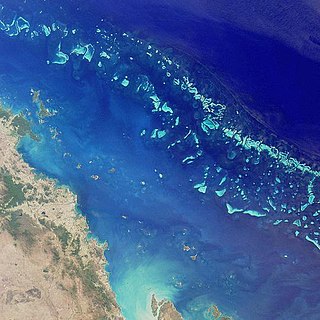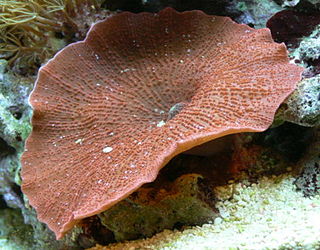
Marine biology is the scientific study of marine life, organisms in the sea. Given that in biology many phyla, families and genera have some species that live in the sea and others that live on land, marine biology classifies species based on the environment rather than on taxonomy.
Genus is a taxonomic rank used in the biological classification of living and fossil organisms as well as viruses, in biology. In the hierarchy of biological classification, genus comes above species and below family. In binomial nomenclature, the genus name forms the first part of the binomial species name for each species within the genus.

The Great Barrier Reef is the world's largest coral reef system composed of over 2,900 individual reefs and 900 islands stretching for over 2,300 kilometres (1,400 mi) over an area of approximately 344,400 square kilometres (133,000 sq mi). The reef is located in the Coral Sea, off the coast of Queensland, Australia. The Great Barrier Reef can be seen from outer space and is the world's biggest single structure made by living organisms. This reef structure is composed of and built by billions of tiny organisms, known as coral polyps. It supports a wide diversity of life and was selected as a World Heritage Site in 1981. CNN labelled it one of the seven natural wonders of the world. The Queensland National Trust named it a state icon of Queensland.

The gastropods, commonly known as snails and slugs, belong to a large taxonomic class of invertebrates within the phylum Mollusca called Gastropoda.

Isopoda is an order of crustaceans that includes woodlice and their relatives. Isopods live in the sea, in fresh water, or on land. All have rigid, segmented exoskeletons, two pairs of antennae, seven pairs of jointed limbs on the thorax, and five pairs of branching appendages on the abdomen that are used in respiration. Females brood their young in a pouch under their thorax.

Heterodonta is a taxonomic subclass of saltwater clams, marine bivalve molluscs. This subclass includes the edible clams, the cockles and the Venus clams.

The Buccinidae are a very large and diverse taxonomic family of large sea snails, often known as whelks or true whelks.

Corallimorpharia is an order of marine cnidarians closely related to stony or reef building corals (Scleractinia). They occur in both temperate and tropical climates, although they are mostly tropical. Temperate forms tend to be very robust, with wide and long columns, whereas tropical forms tend to have very short columns with a wide oral disc and very short tentacles. The tentacles are usually arranged in rows radiating from the mouth. Many species occur together in large groups, although there are recorded instances of individuals. In many respects, they resemble the stony corals, except for the absence of a stony skeleton. Morphological and molecular evidence suggests that they are very closely related to stony corals.
The World Register of Marine Species (WoRMS) is a taxonomic database that aims to provide an authoritative and comprehensive list of names of marine organisms.

Freshwater snails are gastropod mollusks which live in fresh water. There are many different families. They are found throughout the world in various habitats, ranging from ephemeral pools to the largest lakes, and from small seeps and springs to major rivers. The great majority of freshwater gastropods have a shell, with very few exceptions. Some groups of snails that live in freshwater respire using gills, whereas other groups need to reach the surface to breathe air. In addition, some are amphibious and have both gills and a lung. Most feed on algae, but many are detritivores and some are filter feeders.
Lussivolutopsius furukawai is a species of Buccinidae. The species is distributed in the Sea of Okhotsk. The species was first described by Katsura Ōyama in 1951. The species feeds on clams, is found at depths of 4–62 meters, and is generally found in sand.
Lussivolutopsius is a genus of sea snails in the family Buccinidae, the true whelks.
Lussivolutopsius emphaticus is a species of sea snail, a marine gastropod mollusc in the family Buccinidae, the true whelks.
Lussivolutopsius filosus is a species of sea snail, a marine gastropod mollusc in the family Buccinidae, the true whelks.
Lussivolutopsius ivanovi is a species of sea snail, a marine gastropod mollusc in the family Buccinidae, the true whelks.
Lussivolutopsius limatus is a species of sea snail, a marine gastropod mollusc in the family Buccinidae, the true whelks.
Lussivolutopsius marinae is a species of sea snail, a marine gastropod mollusc in the family Buccinidae, the true whelks.
Lussivolutopsius memmi is a species of sea snail, a marine gastropod mollusc in the family Buccinidae, the true whelks.
Lussivolutopsius ochotensis is a species of sea snail, a marine gastropod mollusc in the family Buccinidae, the true whelks.
Lussivolutopsius strelzovae is a species of sea snail, a marine gastropod mollusc in the family Buccinidae, the true whelks.







